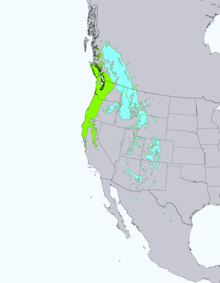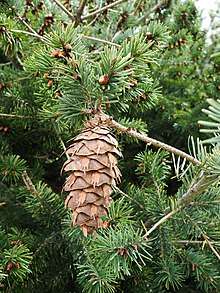Douglas fir
Pseudotsuga menziesii is an evergreen conifer species in the pine family, Pinaceae. It is native to western North America and is known as Douglas fir,[3] Douglas-fir,[4] Oregon pine,[5] and Columbian pine.[6] Despite its common name, it is not a true fir (i.e. it is not a member of the genus Abies). There are three varieties: coast Douglas-fir (P. menziesii var. menziesii), Rocky Mountain Douglas-fir (P. menziesii var. glauca) and Mexican Douglas fir (P. menziesii var. lindleyana).[7]
| Douglas-fir | |
|---|---|
 | |
| Rocky Mountain Douglas-fir forest in Pike National Forest, Colorado (United States). | |
| Scientific classification | |
| Kingdom: | Plantae |
| Clade: | Tracheophytes |
| Division: | Pinophyta |
| Class: | Pinopsida |
| Order: | Pinales |
| Family: | Pinaceae |
| Genus: | Pseudotsuga |
| Species: | P. menziesii |
| Binomial name | |
| Pseudotsuga menziesii (Mirbel) Franco | |
 | |
| Synonyms | |
| |
The massive mega-genome of Douglas fir was sequenced in 2017 by the large PineRefSeq consortium, revealing a specialized photosynthetic apparatus in the light harvesting complex genes.[8]
Naming
The common name honors David Douglas, a Scottish botanist and collector who first reported the extraordinary nature and potential of the species. The common name is misleading since it is not a true fir, i.e., not a member of the genus Abies. For this reason the name is often written as Douglas-fir (a name also used for the genus Pseudotsuga as a whole).[9]
The specific epithet menziesii is after Archibald Menzies, a Scottish physician and rival naturalist to David Douglas. Menzies first documented the tree on Vancouver Island in 1791. Colloquially, the species is also known simply as Doug fir[6] or Douglas pine[6] (although the latter common name may also refer to Pinus douglasiana).[10] Other names for this tree have included Oregon pine,[5] British Columbian pine,[6] Puget Sound pine,[6] Douglas spruce,[6] false hemlock,[5] red fir,[5] or red pine[5] (although again the latter may refer to a different tree species—Pinus resinosa).[11]
One Coast Salish name for the tree, used in the Halkomelem language, is lá:yelhp.[12] In the Lushootseed language, the tree is called čəbidac.[13]
Description
Douglas-firs are medium-size to extremely large evergreen trees, 20–100 metres (70–330 ft) tall (although only coast Douglas-firs reach such great heights)[14] and up to 8 ft (2.4 m) in diameter.[15] The leaves are flat, soft, linear, 2–4 centimetres (3⁄4–1 1⁄2 in) long, generally resembling those of the firs, occurring singly rather than in fascicles; they completely encircle the branches, which can be useful in recognizing the species. As the trees grow taller in denser forest, they lose their lower branches, such that the foliage may start as high as 110 ft (34 m) off the ground.[16] Douglas-firs in environments with more light may have branches much closer to the ground.

The female cones are pendulous, with persistent scales, unlike those of true firs. They are distinctive in having a long tridentine (three-pointed) bract that protrudes prominently above each scale (it resembles the back half of a mouse, with two feet and a tail).
Distribution
Pseudotsuga menziesii var. menziesii, the coast Douglas-fir, grows in the coastal regions from west-central British Columbia southward to central California. In Oregon and Washington, its range is continuous from the eastern edge of the Cascades west to the Pacific Coast Ranges and Pacific Ocean. In California, it is found in the Klamath and California Coast Ranges as far south as the Santa Lucia Range, with a small stand as far south as the Purisima Hills in Santa Barbara County.[17][18] One of the last remaining old growth stands of conifers is in the Mattole Watershed, and is under threat of logging.[19][20] In the Sierra Nevada, it ranges as far south as the Yosemite region. It occurs from near sea level along the coast to 1,800 m (5,900 ft) above sea level in the mountains of California.
Another variety exists further inland, Pseudotsuga menziesii var. glauca, the Rocky Mountain Douglas-fir or interior Douglas-fir. Interior Douglas-fir intergrades with coast Douglas-fir in the Cascades of northern Washington and southern British Columbia, and from there ranges northward to central British Columbia and southeastward to the Mexican border, becoming increasingly disjunct as latitude decreases and altitude increases. Mexican Douglas-fir (P. lindleyana), which ranges as far south as Oaxaca, is often considered a variety of P. menziesii.
Fossils (wood, pollen) of Pseudotsuga are recorded from the Miocene and Pliocene of Europe (Siebengebirge, Gleiwitz, Austria).[21]
Ecology
Douglas-fir prefers acidic or neutral soils.[22] However, it exhibits considerable morphological plasticity, and on drier sites P. menziesii var. menziesii will generate deeper taproots. Pseudotsuga menziesii var. glauca exhibits even greater plasticity, occurring in stands of interior temperate rainforest in British Columbia, as well as at the edge of semi-arid sagebrush steppe throughout much of its range, where it generates even deeper taproots than coast Douglas-fir is capable.
Mature or "old-growth" Douglas-fir forest is the primary habitat of the red tree vole (Arborimus longicaudus) and the spotted owl (Strix occidentalis). Home range requirements for breeding pairs of spotted owls are at least 400 ha (4 square kilometres, 990 acres) of old growth. Red tree voles may also be found in immature forests if Douglas-fir is a significant component. The red vole nests almost exclusively in the foliage of the trees, typically 2–50 metres (5–165 ft) above the ground, and its diet consists chiefly of Douglas-fir needles. A parasitic plant sometimes utilizing P. menziesii is Douglas-fir dwarf mistletoe (Arceuthobium douglasii).
The leaves are also used by the woolly conifer aphid Adelges cooleyi; this 0.5 mm long sap-sucking insect is conspicuous on the undersides of the leaves by the small white "fluff spots" of protective wax that it produces. It is often present in large numbers, and can cause the foliage to turn yellowish from the damage it causes. Exceptionally, trees may be partially defoliated by it, but the damage is rarely this severe. Among Lepidoptera, apart from some that feed on Pseudotsuga in general (see there) the gelechiid moths Chionodes abella and C. periculella as well as the cone scale-eating tortrix moth Cydia illutana have been recorded specifically on P. menziesii.
The coast Douglas-fir variety is the dominant tree west of the Cascade Mountains in the Pacific Northwest, occurring in nearly all forest types, competes well on most parent materials, aspects, and slopes. Adapted to a moist, mild climate, it grows larger and faster than Rocky Mountain Douglas-fir. Associated trees include western hemlock, Sitka spruce, sugar pine, western white pine, ponderosa pine, grand fir, coast redwood, western redcedar, California incense-cedar, Lawson's cypress, tanoak, bigleaf maple and several others. Pure stands are also common, particularly north of the Umpqua River in Oregon.
Poriol is a flavanone, a type of flavonoid, produced by P. menziesii in reaction to infection by Poria weirii.[23]
Uses
The species is extensively used in forestry as a plantation tree for softwood timber. The timber is used for joinery, veneer, flooring and construction due to its strength, hardness and durability.[24] It is also naturalised throughout Europe,[25] Argentina and Chile (called Pino Oregón), and in New Zealand it is considered to be an invasive species, called a wilding conifer, and subject to control measures.
The species has ornamental value in large parks and gardens.[26]
The buds have been used to flavor eau de vie, a clear, colorless fruit brandy.[27]
Native Hawaiians built waʻa kaulua (double-hulled canoes) from coast Douglas-fir logs that had drifted ashore.[28]
Douglas-fir has been commonly used as a Christmas tree since the 1920s, and the trees are typically grown on plantations.[29]
Douglas-fir pine leaves can be used to make pine-needle tea.[30]
Many different Native American groups used the bark, resin, and pine needles to make herbal treatments for various diseases.[31]
The only wooden ships still currently in use by the United States Navy are minesweepers, made of Douglas-fir.[32]
References
- Farjon A (2013). "Pseudotsuga menziesii ". IUCN Red List of Threatened Species. 2013: e.T42429A2979531. doi:10.2305/IUCN.UK.2013-1.RLTS.T42429A2979531.en. Retrieved 16 December 2019.
- "Taxonomy - GRIN-Global Web v 1.10.5.0". npgsweb.ars-grin.gov. Retrieved 24 September 2019.
- "Pseudotsuga menziesii ". Calflora: Information on California plants for education, research and conservation, with data contributed by public and private institutions and individuals, including the Consortium of California Herbaria. Berkeley, California: The Calflora Database – via www.calflora.org.
- Lipscomb, Barney (1993). "Pseudotsuga menziesii ". In Flora of North America Editorial Committee (ed.). Flora of North America North of Mexico (FNA). 2. New York and Oxford. Retrieved 2018-11-07 – via eFloras.org, Missouri Botanical Garden, St. Louis, MO & Harvard University Herbaria, Cambridge, MA.
- "Pseudotsuga menziesii var. menziesii ". Calflora: Information on California plants for education, research and conservation, with data contributed by public and private institutions and individuals, including the Consortium of California Herbaria. Berkeley, California: The Calflora Database – via www.calflora.org.
- Wilson, Donald A. (2008-01-28). Forensic procedures for boundary and title investigation. John Wiley & Sons. ISBN 9780470113691.
- "Pseudotsuga menziesii". Natural Resources Conservation Service PLANTS Database. USDA. Retrieved 2018-11-07.
- Neale DB (2017). "The Douglas-Fir Genome Sequence Reveals Specialization of the Photosynthetic Apparatus in Pinaceae". G3: Genes, Genomes, Genetics. 7 (9): 3157–3167. doi:10.1534/g3.117.300078. PMC 5592940. PMID 28751502.
- "Douglas-fir (Pseudotsuga)". Common Trees of the Pacific Northwest. Oregon State University. Retrieved March 28, 2013.
- Farjon A (2013). "Pinus douglasiana". The IUCN Red List of Threatened Species. IUCN. 2013: e.T42357A2974933. doi:10.2305/IUCN.UK.2013-1.RLTS.T42357A2974933.en.
- "Pinus resinosa". Natural Resources Conservation Service PLANTS Database. USDA. Retrieved 2018-11-07.
- Dictionary of Upriver Halkomelem, Volume I, pp. 213. Galloway, Brent Douglas.
- "čəbidac". March 18, 2017.
- Carder, Al (1995). Forest Giants of the World Past and Present. pp. 3–4.
- Brockman, C. Frank (1968). Trees of North America: A Guide to Field Identification. New York: Golden Press. 280 pp. ISBN 0-307-13658-2. (Pseudotsuga menziesii, pp. 44–45).
- Russell, Tony; Cutler, Catherine; Walters, Martin (2014). The Illustrated Encyclopedia of Trees of the World. London: Anness Publishing Ltd. 511 pp. ISBN 978-1-4351-5597-8. (Pseudotsuga menziesii, p. 120).
- Griffin, James R. (September 1964). "A New Douglas-Fir Locality in Southern California". Forest Science: 317–319. Retrieved December 31, 2010.
- Griffin, James R.; Critchfield, William B. (1976). The Distribution of Forest Trees in California USDA Forest Service Research Paper PSW – 82/1972 (PDF). Berkeley, California: USDA Forest Service. p. 114. Retrieved 2015-05-03.
- "Douglas Fir, Then and Now | The Seattle Times". archive.seattletimes.com.
- "Tensions Rise In the Battle To Save Old Trees". Cal Alumni Association. September 1, 2018.
- file:///C:/Users/user/AppData/Local/Temp/SP_2b.pdf. THE GENUS Pseudotsuga: ANCESTRAL HISTORY AND PAST DISTRIBUTION. pp. 23–24.
- "Douglas-fir Tree on the Tree Guide". arborday.org.
- Barton GM (1972). "New C-methylflavanones from Douglas-fir". Phytochemistry. 11 (1): 426–429. doi:10.1016/S0031-9422(00)90036-0.
- "Douglas-Fir". Wood Database. Retrieved August 15, 2018.
- "Distribution of Douglas-fir". Royal Botanical Garden Edinburgh.
- "Pseudotsuga menziesii ". Royal Horticultural Society.
- Asimov, Eric (August 15, 2007). "An Orchard in a Bottle, at 80 Proof". The New York Times. Retrieved February 1, 2009.
- "Pseudotsuga menziesii var. menziesii ". The Gymnosperm Database. Retrieved March 17, 2013.
This was the preferred species for Hawaiian war canoes. The Hawaiians, of course, did not log the trees; they had to rely on driftwood.
- "Douglas-Fir". National Christmas Tree Association.
- "Foraging for Pine Needles (and other conifer needles)". Grow Forage Cook Ferment. December 23, 2015.
- "Douglas Fir" (PDF). Retrieved 2020-02-21.
- "The Navy's Wooden Avengers Are Real-Life Mine Sweepers". Gizmodo.
Further reading
- Brock, Emily K. (2015). Money Trees: The Douglas-Fir and American Forestry, 1900–1944. Corvallis, Oregon: Oregon State University Press.
External links
- Uchytil, Ronald J. (1991). "Pseudotsuga menziesii var. menziesii". Fire Effects Information System (FEIS). US Department of Agriculture (USDA), Forest Service (USFS), Rocky Mountain Research Station, Fire Sciences Laboratory – via https://www.feis-crs.org/feis/.
| Wikimedia Commons has media related to: |
- Conifers.org: Pseudotsuga menziesii
- Arboretum de Villardebelle – cone photos
- Humboldt State University — Photo Tour: Douglas-fir, Pseudotsuga menziesii — Institute for Redwood Ecology.
- Pseudotsuga menziesii - information, genetic conservation units and related resources. European Forest Genetic Resources Programme (EUFORGEN).
